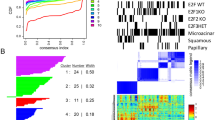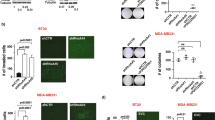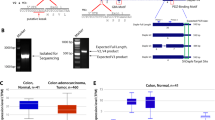Abstract
The Rho family of small GTPases control cell migration, cell invasion and cell cycle. Many of these processes are perturbed in cancer and several family members show altered expression in a number of tumor types. RhoBTB2/DBC2 is an atypical member of this family of signaling proteins, containing two BTB domains in addition to its conserved Rho GTPase domain. RhoBTB2 is mutated, deleted or silenced in a large percentage of breast and lung cancers; however, the functional consequences of this loss are unclear. Here we use RNA interference in primary human epithelial cells to mimic the loss of RhoBTB2 seen in cancer cells. Through microarray analysis of global gene expression, we show that loss of RhoBTB2 results in downregulation of CXCL14—a chemokine that controls leukocyte migration and angiogenesis, and whose expression is lost through unknown mechanisms in a wide range of epithelial cancers. Loss of RhoBTB2 expression correlates with loss of CXCL14 secretion by head and neck squamous cell carcinoma cell lines, whereas reintroduction of RhoBTB2 restores CXCL14 secretion. Our studies identify CXCL14 as a gene target of RhoBTB2 and support downregulation of CXCL14 as a functional outcome of RhoBTB2 loss in cancer.
This is a preview of subscription content, access via your institution
Access options
Subscribe to this journal
Receive 50 print issues and online access
$259.00 per year
only $5.18 per issue
Buy this article
- Purchase on Springer Link
- Instant access to full article PDF
Prices may be subject to local taxes which are calculated during checkout







Similar content being viewed by others

References
Aspenstrom P, Fransson A, Saras J . (2004). Rho GTPases have diverse effects on the organization of the actin filament system. Biochem J 377: 327–337.
Bardwell VJ, Treisman R . (1994). The POZ domain: a conserved protein–protein interaction motif. Genes Dev 8: 1664–1677.
Beder LB, Gunduz M, Ouchida M, Gunduz E, Sakai A, Fukushima K et al. (2006). Identification of a candidate tumor suppressor gene RHOBTB1 located at a novel allelic loss region 10q21 in head and neck cancer. J Cancer Res Clin Oncol 132: 19–27.
Benjamini Y, Hochberg Y . (1995). Controlling the false discovery rate: a practical and powerful approach to multiple testing. J Roy Statis Soc Ser B 57: 289–300.
Chang FK, Sato N, Kobayashi-Simorowski N, Yoshihara T, Meth JL, Hamaguchi M . (2006). DBC2 is essential for transporting vesicular stomatitis virus glycoprotein. J Mol Biol 364: 302–308.
Clark EA, Golub TR, Lander ES, Hynes RO . (2000). Genomic analysis of metastasis reveals an essential role for RhoC. Nature 406: 532–535.
Demaison C, Parsley K, Brouns G, Scherr M, Battmer K, Kinnon C et al. (2002). High-level transduction and gene expression in hematopoietic repopulating cells using a human immunodeficiency (correction of imunodeficiency) virus type 1-based lentiviral vector containing an internal spleen focus forming virus promoter. Hum Gene Ther 13: 803–813.
Frederick MJ, Henderson Y, Xu X, Deavers MT, Sahin AA, Wu H et al. (2000). In vivo expression of the novel CXC chemokine BRAK in normal and cancerous human tissue. Am J Pathol 156: 1937–1950.
Gautier L, Cope L, Bolstad BM, Irizarry RA . (2004). affy—analysis of Affymetrix GeneChip data at the probe level. Bioinformatics 20: 307–315.
Gentleman RC, Carey VJ, Bates DM, Bolstad B, Dettling M, Dudoit S et al. (2004). Bioconductor: open software development for computational biology and bioinformatics. Genome Biol 5: R80.
Hamaguchi M, Meth JL, von Klitzing C, Wei W, Esposito D, Rodgers L et al. (2002). DBC2, a candidate for a tumor suppressor gene involved in breast cancer. Proc Natl Acad Sci USA 99: 13647–13652.
Hromas R, Broxmeyer HE, Kim C, Nakshatri H, Christopherson K, Azam M et al. (1999). Cloning of BRAK, a novel divergent CXC chemokine preferentially expressed in normal versus malignant cells. Biochem Biophys Res Commun 255: 703–706.
Irizarry RA, Hobbs B, Collin F, Beazer-Barclay YD, Antonellis KJ, Scherf U et al. (2003). Exploration, normalization, and summaries of high density oligonucleotide array probe level data. Biostatistics 4: 249–264.
Kelly KF, Daniel JM . (2006). POZ for effect—POZ-ZF transcription factors in cancer and development. Trends Cell Biol 16: 578–587.
Knowles MA, Aveyard JS, Taylor CF, Harnden P, Bass S . (2005). Mutation analysis of the 8p candidate tumour suppressor genes DBC2 (RHOBTB2) and LZTS1 in bladder cancer. Cancer Lett 225: 121–130.
Kobayashi A, Kang MI, Okawa H, Ohtsuji M, Zenke Y, Chiba T et al. (2004). Oxidative stress sensor Keap1 functions as an adaptor for Cul3-based E3 ligase to regulate proteasomal degradation of Nrf2. Mol Cell Biol 24: 7130–7139.
Kurth I, Willimann K, Schaerli P, Hunziker T, Clark-Lewis I, Moser B . (2001). Monocyte selectivity and tissue localization suggests a role for breast and kidney-expressed chemokine (BRAK) in macrophage development. J Exp Med 194: 855–861.
Ohadi M, Totonchi M, Maguire P, Lindblom A, Habibi R, Alavi BA et al. (2007). Mutation analysis of the DBC2 gene in sporadic and familial breast cancer. Acta Oncol 46: 770–772.
Pasqualucci L, Bereschenko O, Niu H, Klein U, Basso K, Guglielmino R et al. (2003). Molecular pathogenesis of non-Hodgkin's lymphoma: the role of Bcl-6. Leuk Lymphoma 44: S5–S12.
Perez-Torrado R, Yamada D, Defossez P-A . (2006). Born to bind: the BTB protein–protein interaction domain. BioEssays 28: 1194–1202.
Prime SS, Eveson JW, Stone AM, Huntley SP, Davies M, Paterson IC et al. (2004). Metastatic dissemination of human malignant oral keratinocyte cell lines following orthotopic transplantation reflects response to TGF-beta 1. J Pathol 203: 927–932.
Ramos S, Khademi F, Somesh BP, Rivero F . (2002). Genomic organization and expression profile of the small GTPases of the RhoBTB family in human and mouse. Gene 298: 147–157.
Redner RL . (2002). Variations on a theme: the alternate translocations in APL. Leukemia 16: 1927–1932.
Ridley A . (2004). Rho proteins and cancer. Breast Cancer Res Treat 84: 13–19.
Ridley AJ . (2006). Rho GTPases and actin dynamics in membrane protrusions and vesicle trafficking. Trends Cell Biol 16: 522–529.
Rivero F, Dislich H, Glockner G, Noegel AA . (2001). The Dictyostelium discoideum family of Rho-related proteins. Nucleic Acids Res 29: 1068–1079.
Sahai E, Marshall CJ . (2002). RHO-GTPases and cancer. Nat Rev Cancer 2: 133–142.
Schaerli P, Willimann K, Ebert LM, Walz A, Moser B . (2005). Cutaneous CXCL14 targets blood precursors to epidermal niches for Langerhans cell differentiation. Immunity 23: 331–342.
Schwarze R, DePrimo SE, Grabert LM, Fu VX, Brooks JD, Jarrard DF . (2002). Novel pathways associated with bypassing cellular senescence in human prostate epithelial cells. J Biol Chem 277: 14877–14883.
Shellenberger TD, Wang M, Gujrati M, Jayakumar A, Strieter RM, Burdick MD et al. (2004). BRAK/CXCL14 is a potent inhibitor of angiogenesis and a chemotactic factor for immature dendritic cells. Cancer Res 64: 8262–8270.
Shurin GV, Ferris RL, Tourkova IL, Perez L, Lokshin A, Balkir L et al. (2005). Loss of new chemokine CXCL14 in tumor tissue is associated with low infiltration by dendritic cells (DC), while restoration of human CXCL14 expression in tumor cells causes attraction of DC both in vitro and in vivo. J Immunol 174: 5490–5498.
Siripurapu V, Meth J, Kobayashi N, Hamaguchi M . (2005). DBC2 significantly influences cell-cycle, apoptosis, cytoskeleton and membrane-trafficking pathways. J Mol Biol 346: 83–89.
Smyth GK . (2005). Limma: linear models for microarray data. In: Gentleman R, Carey V, Dudoit S, Irizarry R, Huber W (eds). Bioinformatics and Computational Biology Solutions using R and Bioconductor. Springer: New York. pp 397–420.
Starnes T, Rasila KK, Robertson MJ, Brahmi Z, Dahl R, Christopherson K et al. (2006). The chemokine CXCL14 (BRAK) stimulates activated NK cell migration: implications for the downregulation of CXCL14 in malignancy. Exp Hematol 34: 1101–1105.
Wilkins A, Ping Q, Carpenter CL . (2004). RhoBTB2 is a substrate of the mammalian Cul3 ubiquitin ligase complex. Genes Dev 18: 856–861.
Yang L, Carbone DP . (2004). Tumor–host immune interactions and dendritic cell dysfunction. Adv Cancer Res 92: 13–27.
Acknowledgements
We thank Ian Paterson for providing the HNSCC cell lines and Adrian Thrasher for the provision of lentiviral reagents. We particularly thank James Doherty, who provided initial analysis of the microarray data. This work was supported by a grant awarded to HM by Cancer Research UK.
Author information
Authors and Affiliations
Corresponding author
Additional information
Supplementary Information accompanies the paper on the Oncogene website (http://www.nature.com/onc)
Rights and permissions
About this article
Cite this article
McKinnon, C., Lygoe, K., Skelton, L. et al. The atypical Rho GTPase RhoBTB2 is required for expression of the chemokine CXCL14 in normal and cancerous epithelial cells. Oncogene 27, 6856–6865 (2008). https://doi.org/10.1038/onc.2008.317
Received:
Accepted:
Published:
Issue Date:
DOI: https://doi.org/10.1038/onc.2008.317
Keywords
This article is cited by
-
Molecular basis and current insights of atypical Rho small GTPase in cancer
Molecular Biology Reports (2024)
-
BTB protein family and human breast cancer: signaling pathways and clinical progress
Journal of Cancer Research and Clinical Oncology (2023)
-
The tumor suppressor RhoBTB1 controls Golgi integrity and breast cancer cell invasion through METTL7B
BMC Cancer (2017)
-
CXCL14 as an emerging immune and inflammatory modulator
Journal of Inflammation (2016)
-
Expression analysis of mouse Rhobtb3 using a LacZ reporter and preliminary characterization of a knockout strain
Histochemistry and Cell Biology (2014)


